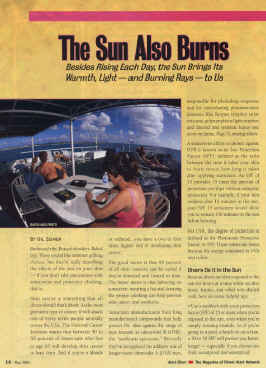Sample Print Portfolio
Magazine Articles
Ads: 1 2 3 4 | Direct Response/Promotions: 1 2
3
4
Web Sites: 1 2
| Ad Banners
| Radio Scripts
| Sell Sheets
Packaging: 1 2
| Brochures
| Magazine Articles
HTML Email/Newsletters
Click here for Magazine index page
The Sun Also Burns
Besides rising each day, the sun brings its warmth, light – and burning rays – to us.
 As it appeared in Alert Diver, The Magazine of Divers Alert Network, May 2001
As it appeared in Alert Diver, The Magazine of Divers Alert Network, May 2001
By Gil Zeimer with additional information provided by Dr. Bruce Miller
Barbecued ribs. Braised shoulders. Baked legs. These sound like summer grilling choices, but they're really describing the effects of the hot sun on your skin - if you don't take precautions with sunscreens and protective clothing.
Skin cancer is something that all divers should think about. As the most prevalent type of cancer, it will attack one of every seven people annually across the USA. The National Cancer Institute warns that between 40 to 50 percent of Americans who live to age 65 will develop skin cancer at least once. And if you're a blonde or redhead, you have a two to four times higher risk of developing skin cancer.
The good news is that 90 percent of all skin cancers can be cured if detected and treated in time. The better news is that lathering on sunscreen, wearing a hat and donning the proper clothing can help prevent skin cancer and sunburns.
Sunscreen manufacturers have long manufactured compounds that help protect the skin against the range of rays known as ultraviolet B (UVB), the "sunburn spectrum." Recently, they've recognized the additive role of longer-wave ultraviolet A (UVA) rays, responsible for photodrug eruptions and for exacerbating photosensitive diseases like herpes simplex solar urticaria, polymorphous light eruption, and discoid and systemic lupus, among others.
A sunscreen's ability to protect against UVB is known as its Sun Protection Factor (SPF), defined as the ration between the time it takes your skin to burn versus how long it takes after applying sunscreen. An SPF of 15 provides 15 times the amount of protection you'd get without using any protection. For example, if you skin reddens after 10 minutes in the sun, your SPF 15 sunscreen would allow you to remain 150 minutes in the sun before burning.
For UVA, the degree of protection is defined as the Phototoxic Protective Factor, or PPF. These values are lower because the energy contained in UVA rays is less.
Divers Do It In
The Sun
Because divers are often exposed to the sun for hours at a time while
on dive boats, kayaks, and other non-shaded craft, here are some helpful
tips:
· Use a sunblock with a sun protection factor (SPF) of 15 or more when exposed to the sun, even when you're simply running errands. So if you're going to a pool, a beach or on a boat, a 30 to 50 SFP will protect you better, longer -- especially if you choose one that's sweatproof and waterproof.
· The lighter your skin, the higher your SPF number should be. Ask your dermatologist or doctor what he/she recommends.
· For maximum effectiveness, reapply your sunscreen every hour and after swimming. Choose one that indicates it is waterproof.
· Use makeups with sunscreening protection. And remember that not all clothes will protect you. Tightly woven, dry clothing are most effective.
· Always wear a broad-brimmed hat, long-sleeve shirts and sunglasses to protect your head, shade your face and arms, and prevent sunburn. (Did you know that an oversized straw golf hat offers 30 SPF?)
· Stop any elective photosensitizing medications while you're on vacation, such as Tetracycline and Retin-A for acne.
· Finally, the most harmful and intense ultraviolet rays are between 10:00 a.m. and 4:00 p.m. - so avoid prolonged exposures during these times.
Remember that you can still burn on a cloudy day, and reflective surfaces like snow, water, sand and concrete can heighten your exposure.
Enjoy your day in the sun, but take care of your skin. Ultimately, you'll be looking after your long-term health.
For a list of Photosensitive Reactions with Drugs, please see the May 2001 issue of Alert Diver.
Gil Zeimer of San
Rafael, CA, has been a UPSNC member since 1986. He prefers 50 SPF sunblock.
Click here for Magazine Index Page

